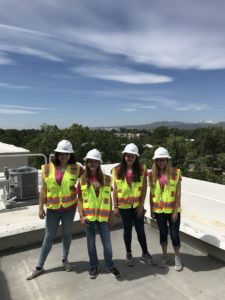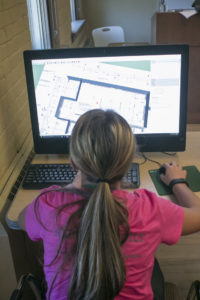Loading LEGO bricks into a small cardboard box and writing out simple instructions for making mac and cheese were part of a groundbreaking camp at CSU that helped high school girls picture themselves in the construction management industry.
The inaugural Women in Construction Management Summer Institute, held June 7-10, also gave several successful alumnae of CSU’s construction management department a chance to tell the high schoolers how they found their place in a male-dominated field.
 “When I was in high school, I didn’t know what all the options were,” says CM alumna Lindsey Blatz, a senior project manager for Webcor Builders in California who was recently named one of that state’s 20 “Top Young Professionals” by Engineering News Record. “When I tell people I’m in construction management, they inspect my fingernails to see if they’re dirty.”
“When I was in high school, I didn’t know what all the options were,” says CM alumna Lindsey Blatz, a senior project manager for Webcor Builders in California who was recently named one of that state’s 20 “Top Young Professionals” by Engineering News Record. “When I tell people I’m in construction management, they inspect my fingernails to see if they’re dirty.”
‘Future co-workers’
Blatz, who graduated from CSU in 2006, returned to campus June 8 to teach the high school girls about digital modeling: taking a two-dimensional drawing and turning it into 3-D.
“They don’t know exactly what the industry is yet, but they might know they want to do something that’s life-changing and skyline-changing,” Blatz says of the high schoolers. “It’s not a very well-publicized industry to get into, so when we see young people who are interested and are going into construction, I get excited because these are going to be my future co-workers that I’m going to be able to mentor — and then eventually work alongside.”
Participants in the institute included seven students from CSU’s Alliance Partnership high schools, seven from a geometry/construction program at Loveland High School, one from Colorado Springs and one from Denver Public Schools. They learned that stereotypes about the construction industry aren’t always accurate.
“Construction is not just swinging a hammer or holding a sign by the side of the highway,” explains Kayla Boos, the department’s student recruitment coordinator and academic adviser. “It’s organization, it’s leadership, and it’s people skills, too. You have to be smart to be in this field, and you have to work hard.”
LEGO bridge
Activities included building a scale model of the San Francisco-Oakland Bay Bridge using LEGO bricks — with a couple of twists. Before assembling it, the girls had to put together a materials list of which bricks they’d need, and how many. Then they created a delivery schedule in which shipments of blocks arrived via small cardboard “barges” — hopefully at the exact time they were needed, since their single “storage barge” could only hold so much material before it got too heavy and “sank.”
“It was about execution,” Boos says. “In construction management, we get the drawings for what we’re building, but we have to figure out the ‘how.’”
Similarly, the participants had to make a step-by-step guide for making mac and cheese, then reduce the time allotted from 35 minutes to 25 minutes — by having some steps occur while waiting for the water to boil.
“It’s all about figuring out which steps are critical, and which steps have some wiggle room,” Boos says. “You do this every day in your own life, too — you start your laundry and then go to the grocery store.”
“If one of the projects I run is a day late, it could cost $20,000,” Blatz explains. “My job is to complete a high-quality job, on budget and on time.”
[masterslider id=”253″]
3-D previewing
During Blatz’s digital modeling session, the participants got to use “mixed-reality” goggles that provide a visual rendering of a construction project in three dimensions. They let users inspect the final product in advance from any angle or distance and ferret out possible problems, such as areas of a structure where space is too tight.
“It’s hard to see those things in 2-D, but in 3-D, you can identify and make changes before you start construction,” Boos says, adding that the girls also learned how to use free SketchUp software. “One girl virtually turned her garage into an aquarium and put a killer whale in it.”
Other activities during the institute included learning from CM Instructor Mike O’Reilly about why a woman’s high heel carries more load per square inch than Godzilla’s foot, visiting the Ginger and Baker redevelopment at the old Northern Colorado Feeders Supply building in Fort Collins, attending a sustainability session with alumnae and industry professionals Amy Powell and Ara Massey, and pouring and wiring their very own working concrete lamps.
“It was great to watch them flip the switch, see the light turn on and say, ‘I did it!’” Boos says. “That was really empowering. And seeing them show off their lamps to their families at the end was so cool.”
 Concluding events
Concluding events
On the final night, participants had dinner at Corbett Hall with about a dozen female professionals in the industry, primarily CSU alumnae. The next day, the institute concluded with a visit to Habitat for Humanity’s Avondale Cottages in south Fort Collins, a project that the girls had studied via construction drawings throughout the camp. There they got hands-on work doing some touch-up painting and radon mitigation.
“It was a good example of how construction can make a really positive impact on people’s lives,” Boos says.
This spring, about 96 percent of graduating students in the CM Department had job offers (2.5 on average) before commencement, and the average starting salary was $62,000 a year.
“Our graduates, especially women, are highly sought-after in the industry,” Boos says. “We wanted to show these high schoolers that they belong here. The institute was a tremendous success, and we are excited to do this for many years to come.”
As for Blatz, she says she nearly chose to attend another university to play golf competitively, but was inspired to pursue construction management after her father acquired a subcontracting company in Colorado Springs.
“I liked the idea of doing something that I could actually see happen — it wasn’t phantom numbers on a computer screen,” she says. “You could see the physical progress.”
Strong foundation
Blatz credits CM faculty, the program’s connections with industry, her internships and, ultimately, the sense of community in the department as the foundation that launched her career.
“I think the program and the professors really get you prepared for taking the next steps when you graduate,” she says. “And then they’re always here as a resource. They’re a group of people that you want to come back and see every semester for different events, and are people that I always lean on for advice, even 10 years out of school.”
Her advice to young women interested in a construction management career?
“Don’t take no for an answer,” Blatz says. “Trust your gut, and work toward the things you believe in. Be confident, and people will realize you are smart. Once people realize you know what you’re talking about, the gender bias goes out the window.”
The Women in Construction Management Summer Institute was made possible with a $15,000 grant from the Office of the Provost. The Department of Construction Management is in CSU’s College of Health and Human Sciences.